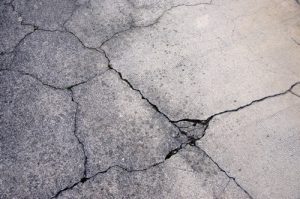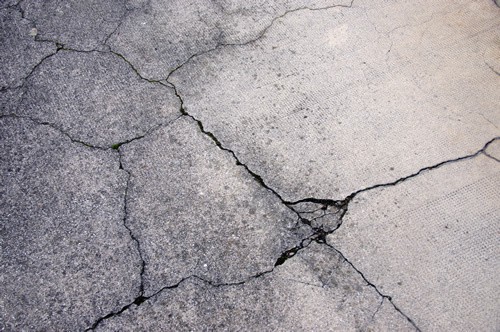
After a hard Illinois winter of freezing temperatures, snow fall, ice storms, and constant thawing and refreezing, your business parking lot might be a mess of cracks, pot holes, or heaving concrete and asphalt. If that’s the case, it’s vital to consider repairs before the next winter quickly slams down on us with another onslaught of cold weather and the harsh freeze-thaw cycle which will can cause even more damage and increase potential injuries. Parking lots are common places for accidents. You don’t need to add dangerous cracks and bumps on frozen and snowy pavement to the mix. As a responsible property owner and manager, now is the time to repair the winter damage.
What you can do this summer to repair your parking lot and prepare for next winter in Chicago?
Asphalt Parking Lot Repairs
According to the U.S. Army Corps of Engineers, asphalt that has cracked, broken, or contains potholes, should be taken down to the stone base and inspected. If there is proper compaction, then new asphalt can be installed. This process is usually done in two lifts. If milling is required, then the existing asphalt should be leveled to specified depth. Repaving or resurfacing the parking lot may also be an option. Many of these options depend on the condition of the existing asphalt.
Routing and Sealing – National Asphalt Paving Association says that any existing or new cracks that formed in the pavement last winter need to be routed and sealed. You can’t leave open cracks as water will penetrate your asphalt causing even more damage and costly repairs. Cracks are normally routed out and blown clean before installing special products for parking lots. It should a product that will stay flexible for the expected high and low temperatures.
Be sure to sealcoat your asphalt. Sealcoating acts as a barrier between the external elements of UV radiation, chemicals, salts and petroleum products. Sealcoat will add flexibility to the pavement.
Concrete Parking Lot and Sidewalk Repairs
Unlike asphalt, concrete tends to "heave." Concrete heaving is when the concrete shifts in its place by movement in the ground beneath it. Normally this is caused by frost. Frost heaving happens when the ground expands upwards due to pressure as ice freezes inside of it and expands. Heaving occurs when the temperature gets cold enough for the water to freeze and it is held there. It is enough to lift a thick layer of soil a full foot, and it can easily shift concrete.
Many times a piece of concrete will shift by a frost heave enough to make a lip, or difference in height, where two concrete surfaces meet. A difference in height presents a serious tripping hazard and a major liability issue along with an undesirable snow plowing surface in winter.
If a piece of concrete is sunken or heaved and the difference in height between one piece and the other is less than 2 ½ inches high, then grinding it down to the same level may fix the problem. However, if larger gaps occur or if the angle doesn’t allow for grinding as a repair, you may need to have mudjacking done or replace the concrete.
Water Drainage and Slope Issues
Another item to take a close look at this summer is where water run off is going to make sure there isn’t water settling in areas that will freeze and cause slipping hazards or heaving. For efficient drainage, paved surfaces should have a minimum 1% slope. Parking lots grades should slope away from structures and toward a lawn, storm sewer or street gutter. If water flows to an area where it cannot completely exit the parking lot, a catch basin and pipe should be installed so the water will drain to its ultimate destination before it refreezes (away from your parking lot).
If you would like to discuss specific questions about preparing your parking lot and sidewalks for winter, please contact us.

